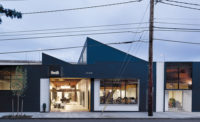When Mexico’s largest financial institution, BBVA Bancomer, decided to move its Mexico City operations center from a Brutalist building in a leafy suburb to Parques Polanco, a development in the city’s emerging mixed-use Nuevo Polanco area, it turned to Skidmore, Owings & Merrill (SOM) for a building that would reinvigorate the company.
The bank had collaborated with the firm on projects in the past, including the interiors of its Herzog & de Meuron–designed Madrid headquarters. SOM also developed the company’s global design standards with the goal, among others, of creating spaces that would attract top-tier talent. These strategies are built into BBVA’s new 30-story, 1.66 million-square-foot home. Employees and visitors sense the new and improved atmosphere upon arrival. “One of the ideas we had about the ground floor was that the lobby would be a street,” says SOM design partner Gary Haney. With a long pool and greenery visible through an adjacent window wall, this avenue runs through the building, terminating in an exterior herb garden used by the cafeteria chefs. The interior boulevard also leads to a shuttle-bus drop-off point and bike path that provide easy access to subway lines—proof, Haney says, that companies with viable alternatives can devote less space to cars.
BBVA invested an additional $8.6 million beyond the cost of the building to engage the changing neighborhood: $4.4 million of that went toward direct community development, such as the planting of 355 trees. “It became a real outreach, way beyond the confines of the site,” Haney says. But the architecture also contributes. Enclosing it with an elegantly shaded skin of aluminum and high-performance glass, SOM designed the building, on target for LEED Gold certification, to minimize its impact on the area’s infrastructure: solar water heating, daylighting, and a cogeneration plant reduce its energy consumption and prevent it from burdening the local power grid; water-efficient fixtures, on-site gray/blackwater treatment, and rainwater harvesting protect the city’s water supply and sewers.
The client is also taking a responsible approach to employee well- being. There is an average of 26 square feet of outdoor space per employee, providing a connection with nature during the workday as well as gathering and meeting places that are refreshing. Inside, the building’s external solar shades assure a comfortable workplace with plenty of sunlight minus the glare and heat, and “communicating” stairs between floors encourage exercise.
The company’s decision to place the cafeteria and amenity spaces at the center of the building, instead of on the ground floor, conveys a sense that the building belongs to everyone. This democratized distribution of space, views, and resources, and the removal of interior partitions within a “vertical city” are tangible reminders of BBVA’s commitment to transparency. And, so far, it’s been a positive factor in shaping a more collaborative rather than top-down approach to business. The dedicated building also reduces operating and real-estate costs. Compared to leasing a newly constructed tower nearby, the ground-up building will save the company 29 percent of those expenses within 10 years.
“I think the big lesson here is that office buildings today are not just about desks, efficiency, and packing people in. They’re much more about lifestyle and amenities,” Haney says. “When you’re competing for a high-end workforce, these things aren’t just nice—they’re necessary.”
Back to Good Design Is Good Business 2017
CreditsArchitect: Skidmore, Owings & Merrill LLP
Personnel in architect's firm who should receive special credit: T. J. Gottesdiener - Managing Partner FAIA
Photographer: Rafael Gamo - All Photos
|
SpecificationsStructural System 1.Typical office level floor framing will consist of reinforced concrete one-way slabs supporting by reinforced concrete beam and girders. The beams and girders will then be supported by reinforced concrete columns and the reinforced concrete core wall system. Manufacturer of any structural components unique to this project: • HALFEN-DEHA Curtain Wall Anchors Exterior Cladding Metal panels: METAL PANEL CLADDING AT PARKING LEVELS: Metal/glass curtain wall: • Curtain Wall Vision Glass: Heat strengthened Pilkington "OptiWhite HS" outer lite with a Viracon "VRE-38" Low-E coating on the #2 surface and a fully tempered Pilkington "OptiWhite FT" inner lite. • Laminated Structural Glass Fins: Three laminated layers of 15mm thick, heat strengthened low iron Lamistar OptiWhite glass with a PVB interlayer. Other cladding unique to this project: • Metal Sunscreens: Glazing Glass: • Insulated Laminated Skylight Glass: Fully tempered Pilkington "OptiWhite FT" outer lite with a Viracon VRE-38 Low-E coating and a "Viraspan V933 - warm gray, screen ceramic frit on the #2 surface; two heat strengthened Pilkington “OptiWhite HS”inner lites. Doors Entrances: • Entrance Doors: Interior Finishes Floor and wall tile: Ceramic Tiles at the Lobby Water Feature: Furnishings Office furniture: • Workstations and offices: Riviera Reception furniture: • Desk – custom Fixed seating: Auditorium seats: Chairs: • Cafeteria – Arper Tables: • Cafeteria – Adnreu Ward Upholstery: • Knoll Textiles Conveyance Elevators/escalators: Wall Mounted Glass Panels in the Passenger Elevator Cabs: |
















Post a comment to this article
Report Abusive Comment